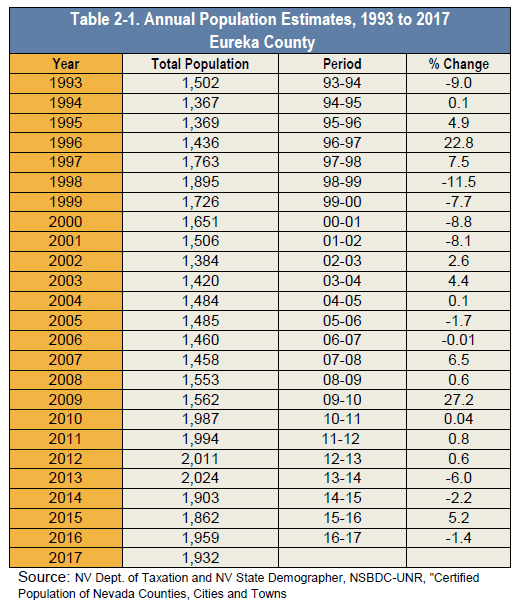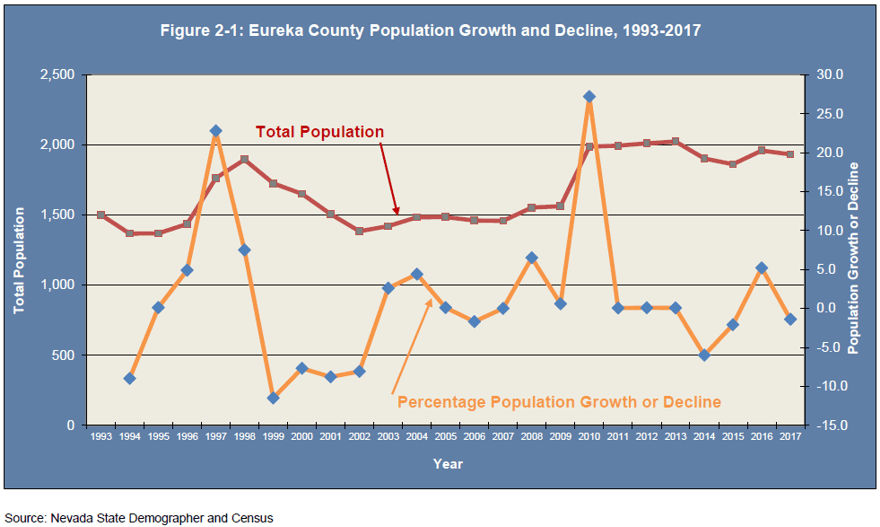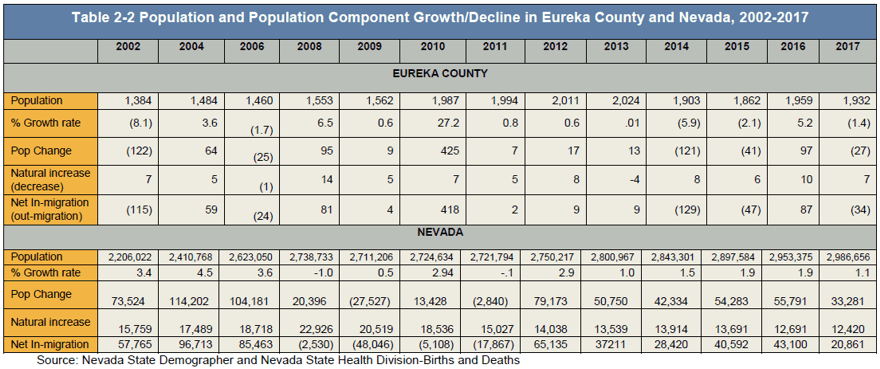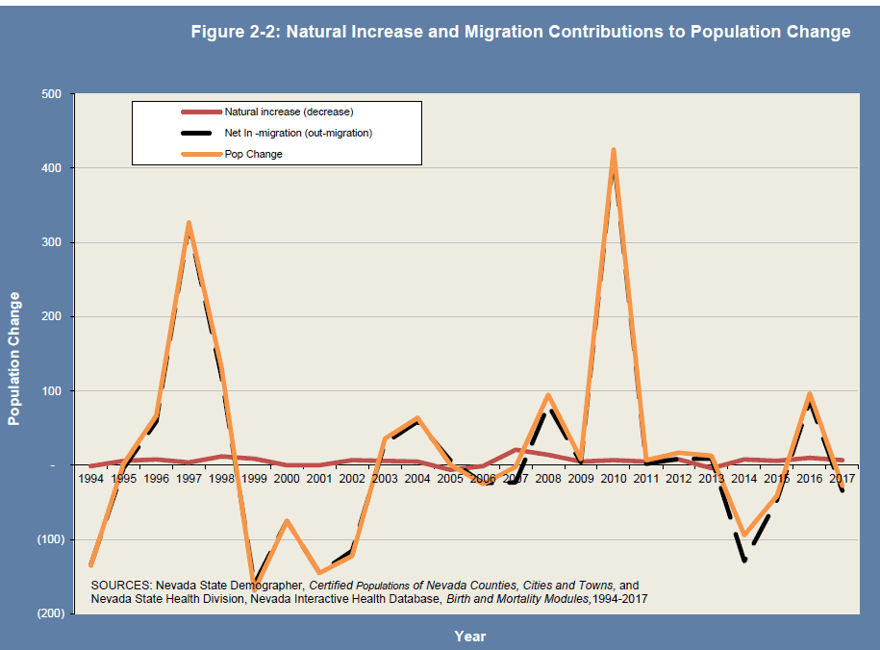Population and Housing
Eureka County Population Growth and Decline
 Eureka County population was estimated to be 1,932 persons in 2017 (Table 2-1) slightly lower than the peak in 2013. This decline is primarily due to a reduction of activity at the Ruby Hill mine. The largest increase in population occurred during 2010 with the release of the official Census population which was substantially higher than the Nevada State Demographer’s annual estimates. The County's average annual population growth over the years 2000-2010 was 2.1 percent. Since 1990 the County population has increased 385 persons. Over the last 23 years, the population for Eureka County has fluctuated primarily due to activity in the mining industry. Population fell sharply in 1994, increased to a high of an estimated 1,895 persons in 1998, and declined reaching a low of 1,384 persons in 2003, before climbing again through 2012 and 2013 (Figure 2-1) and leveling off.
Eureka County population was estimated to be 1,932 persons in 2017 (Table 2-1) slightly lower than the peak in 2013. This decline is primarily due to a reduction of activity at the Ruby Hill mine. The largest increase in population occurred during 2010 with the release of the official Census population which was substantially higher than the Nevada State Demographer’s annual estimates. The County's average annual population growth over the years 2000-2010 was 2.1 percent. Since 1990 the County population has increased 385 persons. Over the last 23 years, the population for Eureka County has fluctuated primarily due to activity in the mining industry. Population fell sharply in 1994, increased to a high of an estimated 1,895 persons in 1998, and declined reaching a low of 1,384 persons in 2003, before climbing again through 2012 and 2013 (Figure 2-1) and leveling off.
As a comparison, the average annual population growth rate of the state of Nevada over the period 1990-2010 was 6.2 percent. From 2000 to 2017 the average annual growth rate for the State of Nevada was 2.9 percent as compared to a 1.0 percent growth rate during the same period in Eureka County.
In Eureka County the greatest part of population change is due to migration as opposed to natural births and deaths (Table 2-2). More people moved out of Eureka County than stayed in the years 2000-2002, while more people moved into the County in the years 2003-2005 and 2008-2013. The rate of natural population change (births minus deaths in the county) was positive in the eighteen-year period except 2006. This "natural" increase is small, however: the year with the highest rate of natural increase was 2007, with an excess of births over deaths of 21 persons. Net migration continued to improve even further from 2008 to 2013 and has remained stable through 2017. The spike in net migration in 2010 is largely due to adjustments made as the result of the Census (Figure 2-2). Prior population estimates are made annually by the Nevada State Demographer. Under certain conditions, annual estimates can be above or below the actual Census figures.


Prior to the 2010 Census, the annual state estimates were below the actual. However, not all the population gains in Eureka County are due to adjustments being made between state estimates and the Census. Substantial and new economic activity in Eureka County primarily related to mining is driving population gains. The level of activity in the mining sector is likely to bolster further population gains. The population of Eureka County remained above 1,900 from 2010 through 2017.

New Mining Activity Will Create Future Populations Gains for Eureka County
Since the beginning of the current mining expansion (2004 - ), the population of Eureka County has exhibited small and consistent increases. Historically, mining operations in Eureka County were primarily located north of Interstate 80 with a few smaller operations scattered throughout the County. As a result, the significant growth in the local workforce in Eureka County did not translate into large local population gains due to the proximity of Carlin Trend mines to neighboring communities of Battle Mountain, Carlin and Elko.
As mining operations and exploration move south along an extension of the Carlin and Battle Mountain trends, future growth in Eureka County and more specifically the Diamond Valley area and the Town of Eureka is increasingly being influenced by new mineral development activity. With Barrick’s Cortez Complex, Horse Canyon, and Mill Canyon project to the north and Midway Gold operations to the south, the Town of Eureka and Diamond Valley are increasingly becoming the geographic center of major gold and silver development activity. Additionally, industrial mineral development could also have a significant impact on the Town of Eureka and Diamond Valley. As a result, population growth should increase substantially over the next decade.
Several mining projects with strong prospects of reaching full operations in and around the Diamond Valley/Town of Eureka area have more than 1,200 projected employees for operational phases not including any of the Barrick’s existing operations at Cortez Hills and Bald Mountain. As Barrick’s operations move further south along the Carlin trend, an increasing number of employees will choose to live in the Diamond Valley/Town of Eureka area. Barrick’s Horse Canyon/Cortez unified project (Gold Rush Deposit) is the company’s next flagship project located six kilometers from the Cortez mine, and is one of the largest and highest-grade gold discoveries of the last decade. Proven and probable reserves stood at 10.09 million ounces at the end of 2017. Operational employment is expected to be on par with Barrick’s other major Carlin Trend mines. The company expects exploration to continue. Due to its proximity to Diamond Valley and the Town of Eureka, significant operational employees are expected to locate to the area.
The proximity of mining projects to the Town of Eureka, and the projected number of operational employees should also generate increased non-mining support services and trade activity as well. Typically, one mining job creates at least one non-mining job in the local economy. Combined, the projected economic activity and associated population growth over the next decade could be substantial and drive demands on local resources and services.
Other Population Statistics for Eureka County
The graphs on the previous and following pages show other characteristics of the population of Eureka County as reported in U.S. Census and subsequent population estimates by the Nevada State Demographer.
Persons per Square Mile
Eureka County has an extremely low population density - only 0.46 persons per square mile, as compared to 27 persons per square mile for Nevada as a whole, and 92.2 persons per square mile nationwide (Figure 2-3). About 56 percent of the estimated 2017 county population of 1,932 resided in the town of Eureka or Crescent Valley, so the actual population density of areas outside of these towns is considerably lower than 0.46 persons per square mile. This is typical of and consistent with the rest of rural northern Nevada, where population tends to be clustered around small towns and cities which grew up as mining towns, local commerce centers serving the surrounding rural areas, or railroad camps. In addition, approximately 81 percent of Eureka County land is managed by the Bureau of Land Management and the U.S. Forest Service, making these areas presently unavailable for settlement.
Population Age Distribution
Eureka County has a relatively young population. 26 percent of the county population, or 520 people, are under the age of 20 (Figure 2-4). Approximately 54 percent of the population, or 1,077 people, are between age 20 and 60, while only 20 percent (248 people) are age 60 or older. Since 2000, the younger population age group (under the age of 20) has declined in Eureka County. This is consistent with State and National trends. As more working age people move into Eureka County for employment, there will likely be an increase in people age 55 and younger. 2016 Census estimates show a similar distribution as 2010 with higher percentage of people over age 60.
Population by Race
Approximately 90 percent of the 2010 population of Eureka County was white (Figure 2-5). This is higher than in Nevada as a whole, where the percentage of white persons in the population in 2010 was 62 percent. People of Hispanic origin comprised 9.4 percent of the 2010 Eureka County population, in comparison to 20.7 percent statewide. American Indians made up 1.9 percent of Eureka County population, a lower percentage than in the state as a whole, which had an estimated 2.0 percent American Indian population. All other races accounted for 5.7 percent of the 2010 Eureka County population. Based upon 2016 Census surveys, race composition in Eureka County remains largely unchanged.
Population Growth in Eureka Town and Crescent Valley
Countywide population trends are mirrored in Eureka town and Crescent Valley (Figure2-6). Both town populations increased until 1998, decreased to 2002, then rose again subsequent years. Since 2013 the population of Eureka County, Eureka Town and Crescent Valley has remained relatively stable with a few minor fluctuations. The overall average annual rate of growth between 1996 and 2017 in Eureka town was 1.8 percent; in Crescent Valley .8 percent. In 2017 the population of Eureka decreased from 732 in 2016 to 701 in 2017 and Crescent Valley Town increased slightly to 380 in 2017.
|

